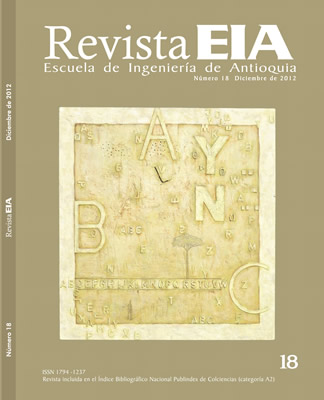DEFINICIÓN DE UN MÉTODO BASADO EN PATRONES DE ANÁLISIS PARA LA INTEROPERABILIDAD ENTRE SISTEMAS DE INFORMACIÓN GEOGRÁFICA (DEFINITION OF AN ANALYSIS-PATTERN-BASED METHOD FOR THE INTEROPERABILITY BETWEEN GEOGRAPHIC INFORMATION SYSTEMS)
DEFINICIÓN DE UN MÉTODO BASADO EN PATRONES DE ANÁLISIS PARA LA INTEROPERABILIDAD ENTRE SISTEMAS DE INFORMACIÓN GEOGRÁFICA (DEFINITION OF AN ANALYSIS-PATTERN-BASED METHOD FOR THE INTEROPERABILITY BETWEEN GEOGRAPHIC INFORMATION SYSTEMS)


This work is licensed under a Creative Commons Attribution-NonCommercial-NoDerivatives 4.0 International License.
Copyright statement
The authors exclusively assign to the Universidad EIA, with the power to assign to third parties, all the exploitation rights that derive from the works that are accepted for publication in the Revista EIA, as well as in any product derived from it and, in in particular, those of reproduction, distribution, public communication (including interactive making available) and transformation (including adaptation, modification and, where appropriate, translation), for all types of exploitation (by way of example and not limitation : in paper, electronic, online, computer or audiovisual format, as well as in any other format, even for promotional or advertising purposes and / or for the production of derivative products), for a worldwide territorial scope and for the entire duration of the rights provided for in the current published text of the Intellectual Property Law. This assignment will be made by the authors without the right to any type of remuneration or compensation.
Consequently, the author may not publish or disseminate the works that are selected for publication in the Revista EIA, neither totally nor partially, nor authorize their publication to third parties, without the prior express authorization, requested and granted in writing, from the Univeridad EIA.
Show authors biography
Los Sistemas de Información Geográfica (SIG) se incorporan en las empresas para facilitar el análisis espacialde la información. Este análisis suele requerir la integración de datos residentes en SIG heterogéneos que tienenla necesidad de interoperar. En los SIG, la interoperabilidad se aborda, principalmente, con la especificación deestándares y la implementación de ontologías, servicios web, computación grid y aplicaciones intermedias. Paraimplementar cualquiera de estos mecanismos, siempre es necesario que un analista realice un estudio detalladodel dominio SIG para cada situación de interoperabilidad que se presente. Este estudio suele ser subjetivo y dependientede la experiencia del analista, lo que afecta su transparencia y dificulta su trazabilidad. Por esta razón,en este artículo se propone un método de interoperabilidad que generaliza la fase de análisis del dominio SIG. Elmétodo consta de siete pasos que se apoyan en patrones de análisis expresados en esquemas preconceptuales.Además, se puede integrar con los mecanismos de interoperabilidad mencionados, reduciendo los tiempos en lafase de análisis y brindando un canal de comunicación entre el usuario, el analista y el desarrollador.
Abstract: Geographic Information Systems (GIS) are incorporated in the companies to facilitate spatial analysis ofthe information. This analysis often requires the integration of GIS heterogeneous data to interoperate. In GIS,interoperability is mainly addressed by the specification of standards and the implementation of several mechanismslike ontologies, web services, grid computing, and middleware technologies. In order to implement any ofsuch mechanisms, an analyst should make a detailed and iterative study of the GIS domain for every situation ofinteroperability is needed. Such study is, commonly, subjective and highly dependent on the analyst experience.Consequently, the entire process seems not to be transparent and traceable. For this reason, in this paper wepropose an interoperability method for generalizing the analysis phase of the GIS domain. The method comprisesseven steps supported by analysis patterns expressed in pre-conceptual schemas. The method can be integratedwith the aforementioned mechanisms for interoperability, thus shortening the analysis phase and providing acommunication channel between the user, the analyst, and the developer.
Article visits 362 | PDF visits 166
